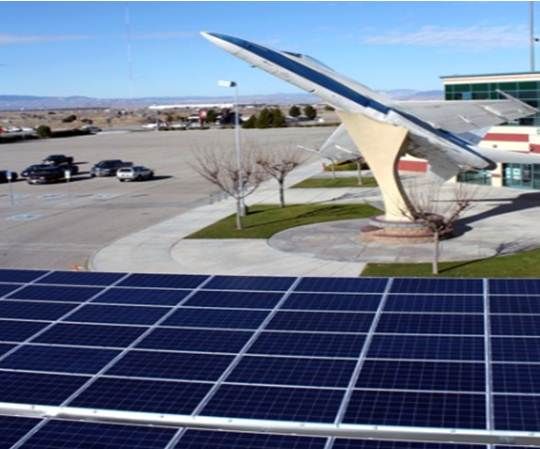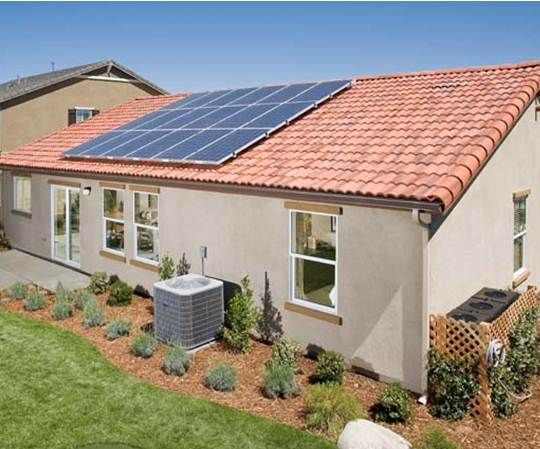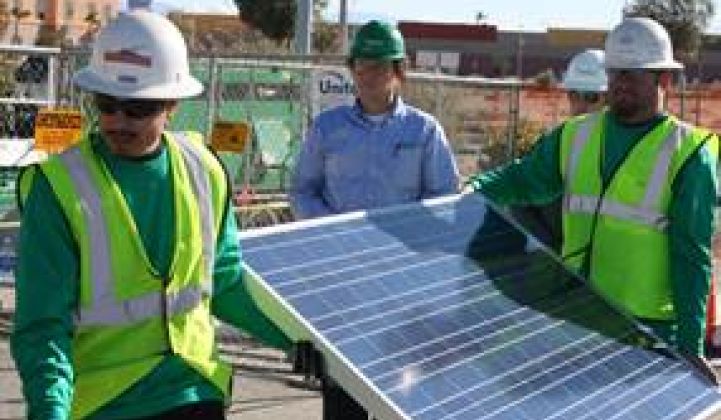Since July 2010, when it began Solar Lancaster, a partnership with third-party finance pioneer SolarCity, the city has facilitated approximately 27 megawatts of installations, including at its baseball field, its performing arts center, City Hall, Lancaster City Park, and an array of businesses and residences.
Buoyed by Solar Lancaster’s success, the city took up a bigger solar ambition. It set out to solarize its school districts with an innovative financing plan.

“The City of Lancaster has been forward-thinking,” observed SolarCity Southern California Region Vice President Jim Cahill. “Some of this stuff has not been done before.”
“Solar Lancaster was dipping our toes into the water,” explained Public Works Projects Coordinator Heather Swan, who moved into the city’s solar program from the local office of the state’s Redevelopment Agency. “With the SolarCity partnership, we got a little more familiar. Then we moved into the school districts, getting deeper into the water. And now we’ve jumped in all the way.”
Two of Lancaster’s school districts are now guaranteed an electricity rate reduction from eighteen cents per kilowatt-hour to 12.5 cents per kilowatt-hour. Their solar will save them $325,000 or more annually for 25 years.
Thanks to those savings and the City’s revenue stream, solar will keep teachers in classrooms, cops and firefighters on the job, public parks and museums available to kids, and so on.
Lancaster’s staff speaks of Mayor R. Rex Parris’s leadership. “The Mayor has said,” noted Communications Manager Joe Cabral, “the Middle East is sitting on oil. We’re sitting underneath the sun. Why in the world wouldn’t you monetize it?”
To build the school district’s solar, Mayor Parris and the City Council took the risky step of issuing a tax-exempt municipal bond. Now fully sold, it raised $27 million.
The successful close of the bond sale proved the concept, said Deputy City Manager Jason Caudle, a former investment banker who worked out the financial details of Mayor Parris’ vision.
Wedbush Securities underwrote the bond at an average 4.4 percent interest, Caudle explained. “They have an obligation to buy all the bonds from us, but they also have the opportunity to sell the bonds in the open market.” And, he added, “as long as we keep paying on the bonds, they make at least 4.4 percent, tax-free.”
Because of that low cost of capital, Swan said, “we have a cheaper cost of power and can offer a cheaper cost of power to the school districts, providing them their savings.”
The school districts continue to pay Southern California Edison (SCE), but their combined bills are significantly less than if they were buying all their power from SCE. And, Swan added, “the amount of money they pay us in total is greater, every year, than the amount of money we owe in debt service on the bonds. The difference is the amount of the city’s revenue.”
The bond funded 7.5 megawatts of solar, built at 25 school district sites, Swan said. “We pre-paid the power for 25 years. SolarCity is paid.”
“Sometimes when we talk to a city about this degree of going solar,” SolarCity’s Cahill said, there is “an aversion to doing a new structure.” There was, he said, no aversion in Lancaster.

SolarCity guaranteed the city a minimum amount of kilowatt-hours and took responsibility for system installation and maintenance. SolarCity benefited from the 30 percent federal investment tax credit and from accelerated depreciation of the system, both unavailable to the non-taxpaying city and school district.
What has emerged is Lancaster’s California Clean Energy Authority (CCEA). Through it, Lancaster will partner with developers like SolarCity and form Joint Powers Agreements (JPAs) with other California cities. It is a Property Assessed Clean Energy (PACE)-like structure that benefits municipalities but avoids the Federal Housing Authority objections that stopped PACE’s initial success.
“This is basically taking the model of what we have done with our school districts and doing the same thing with other school districts and others, fire departments, police stations, waste treatment plants, and so on across the state,” explained Mayor Parris. “We are already in talks with five or six other cities.”
“We’re talking to cities,” Swan added, that are “too financially strained to put people on it or that may not have the political will to do their own program.” The business model, she said, could work anywhere.
"The basic core of any solar deal,” Cahill said, is “the utility rates have to be high enough. The sun resource has to be great. In Lancaster, it’s better than almost anywhere. And you have to have the physical space.” If those points are met, he said, “then you start working on the financing end.”
The Lancaster representatives spoke highly of SolarCity but would not rule out working with other developers. “There are so many megawatts out there to build,” Swan said, “I don’t know that any one developer can do it all.”



